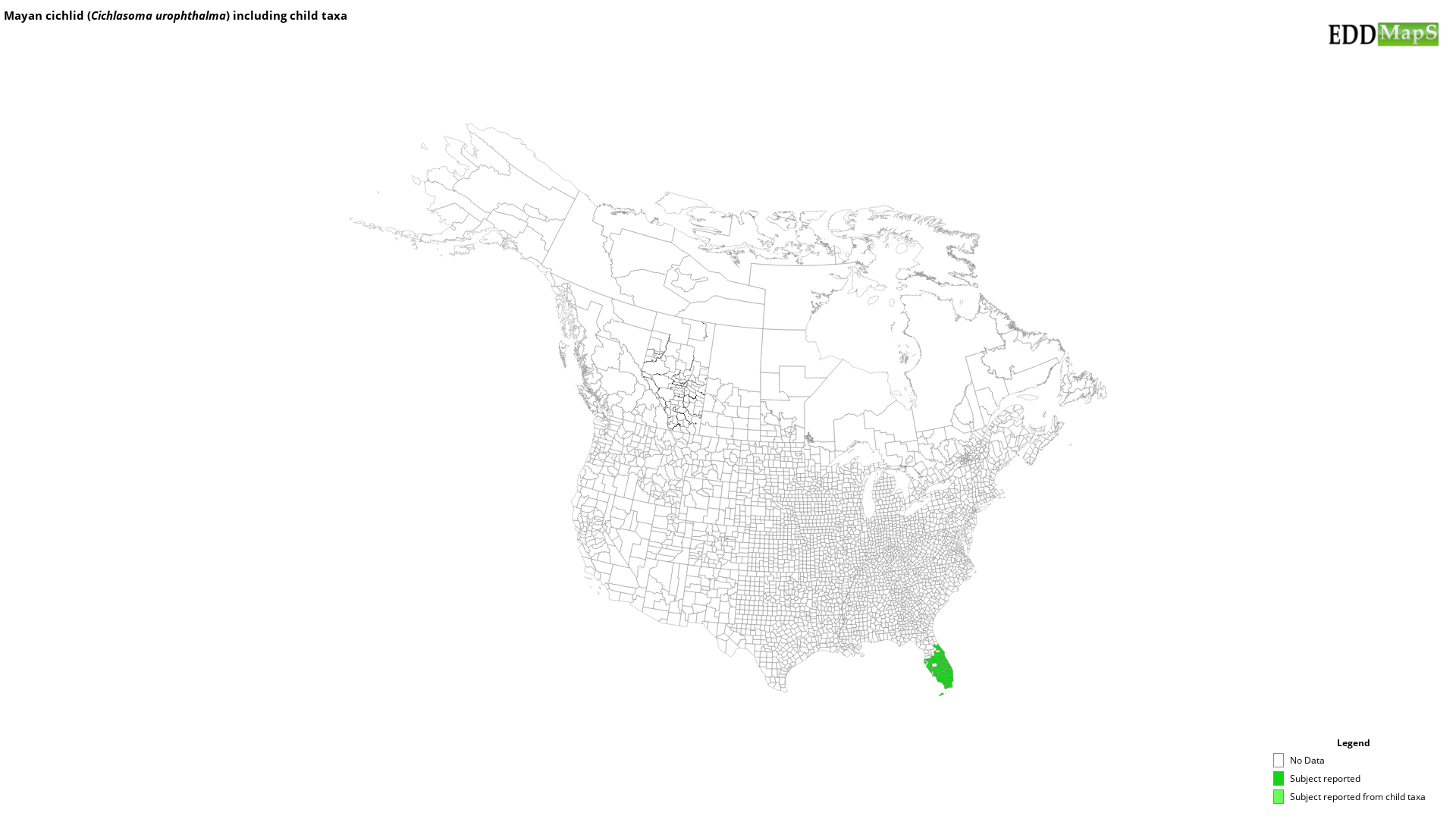Mayan cichlid
(Cichlasoma urophthalma)
This species is Introduced in the United States
Origin
Cichlasoma urophthalma is native to the Atlantic slope of Central and South America. Mayan cichlid were introduced to the United States likely as accidental releases of aquarium pets.
Life Cycle
Mayan cichlid closely resemble native sunfish with an ovate body and spiny first dorsal and anal fins. The most distinguishing feature is their coloration with an olive-brown background color on the back that shade to light brown or beige toward the belly. Wide green-black bars start behind the head and continue toward the tail. An “eye-spot” is located on the tail and is silver-blue in color. C. urophthalma average approximately 10 in. (25.4 cm) in length. C. urophthalma are very adaptable and can live in various habitats. Spawning occurs once per year with both parents guarding young for up to 6 weeks.
Distribution
C. urophthalma has establish population in south Florida and as far north as Lake Okeechobee and the St. Lucie Canal.
Control Efforts
Mayan cichlid are used as fish food, exploited as a game fish, and bred for the aquarium trade. C. urophthalma has been observed consuming native centrarchids in the Everglades National Park.
https://nas.er.usgs.gov/Queries/FactSheet.aspx?speciesID=453
https://myfwc.com/wildlifehabitats/profiles/freshwater/mayan-cichlid/
https://www.floridamuseum.ufl.edu/discover-fish/species-profiles/mayaheros-urophthalmus/
Cichlasoma urophthalma is native to the Atlantic slope of Central and South America. Mayan cichlid were introduced to the United States likely as accidental releases of aquarium pets.
Life Cycle
Mayan cichlid closely resemble native sunfish with an ovate body and spiny first dorsal and anal fins. The most distinguishing feature is their coloration with an olive-brown background color on the back that shade to light brown or beige toward the belly. Wide green-black bars start behind the head and continue toward the tail. An “eye-spot” is located on the tail and is silver-blue in color. C. urophthalma average approximately 10 in. (25.4 cm) in length. C. urophthalma are very adaptable and can live in various habitats. Spawning occurs once per year with both parents guarding young for up to 6 weeks.
Distribution
C. urophthalma has establish population in south Florida and as far north as Lake Okeechobee and the St. Lucie Canal.
Control Efforts
Mayan cichlid are used as fish food, exploited as a game fish, and bred for the aquarium trade. C. urophthalma has been observed consuming native centrarchids in the Everglades National Park.
https://nas.er.usgs.gov/Queries/FactSheet.aspx?speciesID=453
https://myfwc.com/wildlifehabitats/profiles/freshwater/mayan-cichlid/
https://www.floridamuseum.ufl.edu/discover-fish/species-profiles/mayaheros-urophthalmus/
Resources
- Florida's Exotic Wildlife Species Detail - Florida Fish and Wildlife Conservation Commission
Selected Images
Maps
EDDMapS Distribution - This map is incomplete and is based only on current site and county level reports made by experts, herbaria, and literature. For more information, visit www.eddmaps.org
State Lists - This map identifies those states that have this species on their invasive species list or law.
Invasive Listing Sources
Taxonomic Rank
| Domain: Eukarya |
| Kingdom: Animalia |
| Phylum: Chordata |
| Subphylum: Vertebrata |
| Class: Actinopterygii |
| Subclass: Neopterygii |
| Order: Perciformes |
| Family: Cichlidae |
| Genus: Cichlasoma |
| Cichlasoma urophthalma |
References
Common Name Reference: Integrated Taxonomic Information System on-line database.
Scientific Name Reference: Integrated Taxonomic Information System on-line database.


